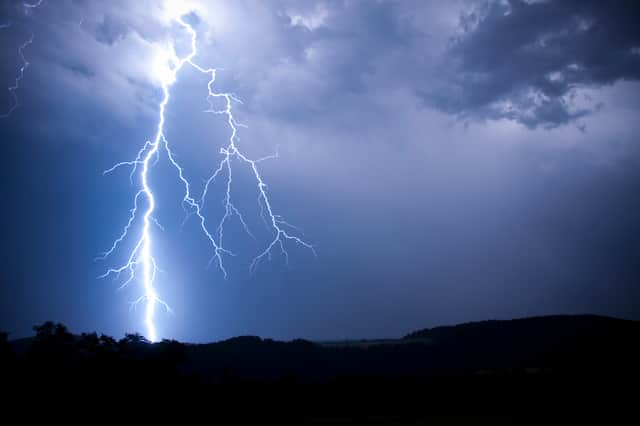What is thunder? Causes and weather feature explained as heat sparks storms across the UK
and live on Freeview channel 276
The UK has been experiencing some of the hottest temperatures of the year in recent days, with highs of 32C being recorded in some areas amid an ongoing heatwave.
Along with prolonged warm weather, people have been warned to expect thunderstorms across the country and in some areas the storms have already begun. The Met Office issued four yellow warnings for thunderstorms on Monday (12 June) and two of these are still in place today (13 June).
Advertisement
Hide AdAdvertisement
Hide AdThe warnings are in place between midday and 9pm and cover areas between Inverness and Glasgow in Scotland and also Londonderry and Derry in Northern Ireland. The Met Office has said there is the potential that a large amount of rainfall will fall in a short period of time and 20 to 30mm of rain may fall within an hour or less. It’s also possible that 40 to 50mm may fall in successive showers in the same area. Frequent lightning is also likely and there may also be hail.
But, what exactly is thunder, how does it occur and how common are thunderstorms? Here’s what you need to know.
What is thunder?
Thunder is the sound produced by the rapid heating of air by a lightning strike. It is referred to commonly as a thunder clap because of the loud and sudden sound it creates. The Met Office explains that when lightning strikes, the narrow channel of air through which it travels reaches temperatures of up to 30,000C almost instantly. This intense heat causes the air to rapidly expand outward into the cooler air surrounding it which creates a rippling shockwave. This is what we hear as a rumbling thunder clap sound.
The sound of thunder can present in two ways depending on how it’s formed and the location of it. It can either be a brief loud crack or a longer and slightly quieter rumble through the air. The louder the thunder, the closer the lightning. When the lightning strike is close, the sound of the thunder will be loud and short. Both lightning and thunder are created simultaneously but thunder will always be heard after the lightning strike is seen because light travels much faster than sound.


What causes thunder?
Advertisement
Hide AdAdvertisement
Hide AdThunderstorms happen when warm air sits underneath much colder air, causing an unstable atmosphere, says the Met Office. Thunder occurs at the same time as lightning which happens when a negative charge is attracted to the Earth's surface and other clouds and objects.
This negative charge begins to build when warm air rises, cools, condenses and forms water droplets. When the air is unstable these water droplets will quickly form a cumulonimbus cloud, which is a specific type of cloud that can produce hail, thunder and lightning. As the warm air continues to rise, the water droplets combine to create larger droplets which then freeze to form ice crystals. Eventually, these crystals become too heavy to be supported by the updraughts of air and they fall back to the ground as hail. As hail moves within the cloud, it picks up a negative charge by rubbing against smaller positively charged ice crystals.
When the attraction between the negative charge and the Earth becomes too strong, the positive and negative charges come together and this balances the difference between the two in a flash of lightning. The rapid expansion and heating of air caused by the lightning then produces the accompanying thunder sound.
How common are thunderstorms?
Thunderstorms are common across the world, according to the Met Office. It is estimated that a lightning strike hits somewhere on the Earth's surface approximately 44 times every second, a total of nearly 1.4 billion lightning strikes every year. As they are caused by intense heat, they are most common in areas where the weather is consistently hot and humid. In the UK, therefore, they are not particularly frequent but can occur during heatwaves. The most common areas in the UK for thunderstorms are over the East Midlands and the southeast.
Seen any lightning strikes where you are? Send us your pictures at [email protected] or on Twitter @Rochelle_Malise if you want to be featured.
Comment Guidelines
National World encourages reader discussion on our stories. User feedback, insights and back-and-forth exchanges add a rich layer of context to reporting. Please review our Community Guidelines before commenting.
